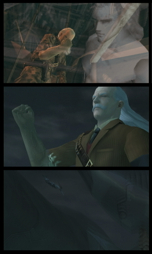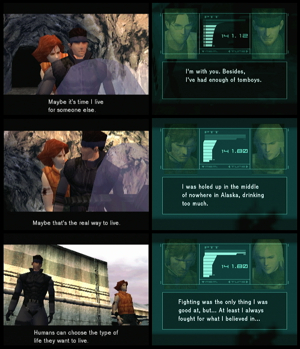MGS2 binged after it had purged MGS1. The player had needed
to use Raiden’s sword and was forced to view Raiden in third-person—a kind
of exorcism—yet the fight against twenty-five Metal Gear Rays once again
immersed the player in his actor. He had to enter Raiden’s first-person view
to fire Stinger missiles at the Rays, and he did so in an arena exactly copied
from the Virtual Reality Missions in MGS1. Raiden appeared in the
center of an octagonal stage, where (in MGS1) a woman had appeared whom
the player voyeuristically photographed. Now Raiden self-consciously occupied
the center of attention.
However, MGS2 expelled MGS1 right after Raiden gave up. It wrecked the possibility for Raiden to redeem his failures during the Plant Chapter, while it simultaneously opened the possibility to redeem Snake’s failures during the Tanker Chapter. It shut the player off from MGS1’s remaining cast, ensuring that he would never again witness MGS1’s drama during MGS2 first-hand.
Enemies claimed Raiden’s expected catharses. Solidus Snake destroyed all but one of the remaining Metal Gear Rays, and Ocelot slew the invincible Fortune. Raiden’s principle antagonist, Solidus Snake, was revealed not to have been the most important enemy, but the real enemy’s manipulated patsy.
The final encounter atop Arsenal Gear confused all players everywhere. Liquid Snake spiritually possessed Ocelot, hijacked the remaining Metal Gear Ray, and dove off Arsenal’s edge. Solid Snake jumped overboard in hot pursuit.

|
Both Liquid and Ocelot had been responsible for the events of MGS1, albeit with different levels of transparency. Liquid had been Snake’s most obvious enemy, while Ocelot had encouraged Liquid’s plans via conspiracy. Appropriate to form, MGS2 reversed that relationship when Liquid invisibly influenced Ocelot’s actions.
Liquid Snake loomed large in the player’s memory of MGS1. Liquid had wanted to revive the global demand for mercenaries, and MGS1 had narrated to the player that the plot’s emergencies had risen from Liquid’s pursuit of his goals. Liquid’s return during the Tanker Chapter had signified that the player would again need to contend with Liquid, clearly placing MGS2 on the Series Map. Snake’s rivalry with Liquid—brother versus brother—had formed a large chunk of the Scenario Map, and his return had recalled his persistence in MGS1. Finally, Snake had been recruited for MGS1 because he and Liquid were genetic twins. Liquid Snake had been responsible for the context that forced Solid Snake to become the hero of Shadow Moses.
Ocelot had shared Liquid’s roles, albeit passively. He had sold the blueprints for Metal Gear Rex after MGS1 and perpetuated its threat, making the sequel to Metal Gear Solid inevitable. He had also filled the role of Grand Conspirator, an element of the Scenario Map. Finally, he had prodded Liquid into igniting MGS1’s emergencies, thereby equally contributing to the events that made the Solid Map possible.
Despite MGS1’s hardships, Snake had left the battlefield on a hopeful note. Two of MGS1’s overt themes were an individual’s power to defy his genetic fate and the possibility of love under the duress of war. Liquid had believed that his and Snake’s “warrior genes” led them inevitably to war, and Snake had decided to defy Liquid’s fatalism by living peacefully with Meryl Silverburgh, MGS1’s love interest. One of MGS1’s supporting characters had expressed the game’s optimism in a single phrase: “Choose life—and then live.”

|
MGS2 dramatized everything that had gone wrong since MGS1 when Liquid-Ocelot appeared to have killed Snake. The player’s and Snake’s victories had been hollow. Everything that had justified a sequel to Metal Gear Solid—Ocelot’s role as a conspirator, Liquid’s role as a rival, and Snake’s role as a hero—had failed the player’s expectations.
MGS1’s form suddenly revived when Liquid-Ocelot appeared atop Arsenal Gear. Snake had a chance to redeem his former defeat to Liquid and Metal Gear Ray. Raiden’s and Snake’s shared battle through the hangar had suggested that the player would at least help redeem Snake’s failure, but MGS2 refused to cooperate. After having corrupted the Series Map by spoiling all of MGS1’s achievements, MGS2 barred the player from even watching how those narrative threads resolved. MGS2 had made Snake’s physical presence a condition of Liquid’s emergence—thereby reinforcing the Scenario Map—and the player couldn’t engage that element because Snake wasn’t his actor. Finally, Liquid had reappeared only after Raiden had realized that he wasn’t Solid Snake.
Redemption had become possible at last, and the player couldn’t share it.
When Liquid Snake
hijacked both Ocelot and Ray, MGS1’s two biggest enemies, its doomsday
machine, and its hero all left. They took the Solid Map with them, and they
left the player to crash Arsenal Gear into New York City.